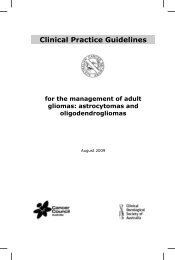Clinical Practice Guidelines for the management of locally advanced ...
Clinical Practice Guidelines for the management of locally advanced ...
Clinical Practice Guidelines for the management of locally advanced ...
You also want an ePaper? Increase the reach of your titles
YUMPU automatically turns print PDFs into web optimized ePapers that Google loves.
have to be weighed against <strong>the</strong> impact <strong>of</strong> ADT on quality <strong>of</strong> life. This issue is relevant as <strong>the</strong>re is a<br />
large number <strong>of</strong> men with prostate cancer who are not suitable <strong>for</strong> definitive local <strong>the</strong>rapy and as <strong>the</strong>se<br />
studies reflect, this is <strong>of</strong>ten a disease found in elderly men.<br />
Evidence summary Level References<br />
For <strong>locally</strong> <strong>advanced</strong> disease <strong>the</strong> body <strong>of</strong> data <strong>for</strong> androgen<br />
suppressive <strong>the</strong>rapy (medical or surgical) appears consistent in that<br />
immediate treatment shows a disease-specific survival advantage<br />
and on occasion an overall survival advantage. However, <strong>the</strong><br />
overall impression suggests that if <strong>the</strong>re is a benefit, it is modest.<br />
Recommendation<br />
II 1-3, 6, 7<br />
No strong recommendation can be made <strong>for</strong> <strong>the</strong> use <strong>of</strong> androgen deprivation <strong>the</strong>rapy in<br />
<strong>locally</strong> <strong>advanced</strong> disease. However, <strong>the</strong>re may be a modest benefit <strong>for</strong> immediate or<br />
primary androgen deprivation <strong>the</strong>rapy <strong>for</strong> patients with <strong>locally</strong> <strong>advanced</strong> disease deemed<br />
not suitable <strong>for</strong> definitive local <strong>the</strong>rapy. However, this has to be weighed against <strong>the</strong> impact<br />
<strong>of</strong> androgen deprivation <strong>the</strong>rapy on quality <strong>of</strong> life.<br />
Grade C<br />
Choice <strong>of</strong> androgen deprivation <strong>the</strong>rapy<br />
Given <strong>the</strong> finding that <strong>the</strong>re is possibly a modest benefit <strong>for</strong> use <strong>of</strong> primary ADT <strong>for</strong> <strong>locally</strong> <strong>advanced</strong><br />
prostate cancer, it is reasonable to ask whe<strong>the</strong>r one <strong>the</strong>rapy is better than ano<strong>the</strong>r. Again, whilst <strong>the</strong>re<br />
is extensive data dating back to <strong>the</strong> 1970s and <strong>the</strong> analysis is complicated by <strong>the</strong> reasons listed in <strong>the</strong><br />
dot points above. If primary ADT is to be used, data would support castration. There was one RCT<br />
and two quasi-randomised trials showing a trend towards higher mortality rates with oestrogens as<br />
compared with orchidectomy at four years and longer follow-up, 1, 8-10 and RCTs suggesting a trend<br />
towards lower overall survival with anti-androgens alone when compared with medical or surgical<br />
castration 11 or combined androgen blockade. 12<br />
This leads to <strong>the</strong> question as to whe<strong>the</strong>r combined androgen blockade (CAB) is better than castration<br />
alone <strong>for</strong> <strong>locally</strong> <strong>advanced</strong> disease. There is no definitive comparative trial answering this question in<br />
this patient population, with most trials comparing CAB with castration focusing on metastatic<br />
disease. Subgroup analyses <strong>for</strong> patients without evidence <strong>of</strong> metastatic disease (M0) did not show a<br />
survival benefit <strong>for</strong> combined androgen deprivation <strong>for</strong> <strong>the</strong> M0 population 13,14, 15 . The Prostate Cancer<br />
Trialists’ Collaborative Group 13 found a small benefit <strong>for</strong> non-steroidal anti-androgen plus castration<br />
in M0 and M1 patients combined (12% M0) but did not analyse separately <strong>the</strong> effects <strong>of</strong> adding nonsteroidal<br />
anti-androgens <strong>for</strong> men with non-metastatic disease. Notably, <strong>the</strong> steroidal anti-androgen,<br />
cyproterone plus castration group was slightly worse than castration alone <strong>for</strong> <strong>the</strong> combined group <strong>of</strong><br />
M0 and M1. There<strong>for</strong>e, <strong>the</strong>re are no data <strong>for</strong> or against using CAB <strong>for</strong> <strong>locally</strong> <strong>advanced</strong> disease and<br />
<strong>the</strong> data that do exist suggest no survival benefit. Given <strong>the</strong> incremental toxicity with CAB, this<br />
additional <strong>the</strong>rapy cannot be used without <strong>the</strong> risk <strong>of</strong> a detrimental effect on quality <strong>of</strong> life. There<strong>for</strong>e<br />
<strong>the</strong>re are no data to mandate CAB if primary ADT <strong>the</strong>rapy is going to be used in patients with <strong>locally</strong><br />
<strong>advanced</strong> prostate cancer.<br />
<strong>Clinical</strong> practice guidelines <strong>for</strong> <strong>the</strong> <strong>management</strong> <strong>of</strong> <strong>locally</strong> <strong>advanced</strong> and metastatic prostate cancer<br />
18



